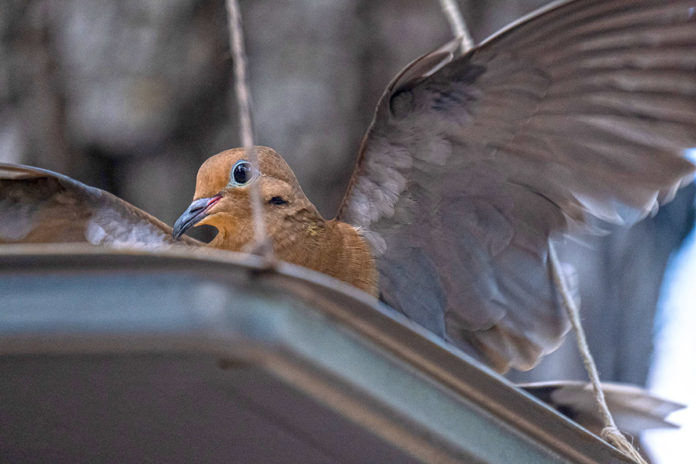4:06 p.m. Everything was darker than it should have been because it had been raining all day. It was still cloudy and the deck, table and tree were all wet, which somehow brought out the red in the legs of the mourning doves in the backyard. Not sure why, but the low-level vibrance was appreciated.
There were three of them, two on the deck and one on the table.
I really didn’t want to disturb them, but they were looking for more bird seed, and the only way they were going to get that was if I went out and disturbed them. So I opened the kitchen door and the mourning doves did what mourning doves do – panicked and fled.
I grabbed the Talenti jar – such useful things, and a great rationale for eating gelato – and dug it through the trash can we use to store the bird seed, then lifted the jar above my head and poured it into the bird feeder. The feeder was really just a tray from an old toaster oven, hung with twine from an old broom handle that jutted horizontally from the high stump of an old mahogany tree. I’d be depressed about having a giant stump in the backyard, except it was from an occluded twin of a mahogany that’s still standing.
4:18 p.m. The mourning doves were the first to figure out the feeder when we put it up a couple months back, and were still its most common clients, but the first bird to belly up – belly down, really – was a Eurasian collared-dove. Big and beige with that inverse priest’s collar around its neck. It didn’t waste time, but started going at the pile immediately with these fast, full-body, pile-driver pecks, sending a serious portion of the feed flying over the side of the feeder. I timed it and the bird was hitting the seed pile about 95 times a minute.
4:24 p.m. A mourning dove came in and landed on the broomstick over the feeder. It was tentative at first, but clearly looking to make a move, and it was obvious how it was going to go. A Eurasian collared-dove weighs about seven ounces. A mourning dove weighs about four. Mass always wins. Except when it doesn’t.
The Eurasian collared-dove stabbed at the mourning dove with its bill, but the mourning dove held its ground. The Eurasian collared-dove threw its wings up and lunged at the mourning dove, but the smaller bird just crouched lower. Then the mourning dove threw itself at the collared-dove and the collared-dove fled, flapping two or three times until it landed on the nearby string of lights that stretched between the house and the Christmas palm.
Victory for the little guy. Or maybe gal. It’s really hard to sex doves.
The deposed Eurasian collared-dove faced the other direction for a few moments, then turned around and faced the feeder, looking, no doubt, as bullies everywhere do, for vulnerabilities and ways to exploit them.
The mourning dove was making its effort at the seed pile, though its technique varied. Its pecks were also about 95 a minute, but instead of a full head-up-and-down cycle with each peck, it only lifted its head a third of the way up. Every 15 pecks, though, it did a full cycle, throwing its head back, maybe needing to gulp down an accumulation of seeds all at once.
4:26 p.m. The Eurasian collared-dove attempted a return, jumping from the wire to the feeder, but the mourning dove stabbed at it with its bill when it got close, and the collared-dove U-turned in midair and retreated to the string of lights.
4:27 p.m. The collared-dove flew at the feeder again. This time the mourning dove, maybe having had its fill, ceded the territory and took off without a fight. The collared-dove seemed a little nonplussed by its own success, but after a moment returned to full-bodied pecking.
Traffic slowly increased in the yard. There were now two additional Eurasian collared-doves, three mourning doves, and a common ground dove down on the damp wood of the deck. One of the mourning doves flew up and deposed the Eurasian collared-dove. Then one of the Eurasian collared-doves from the deck flew up and deposed the mourning dove.
The common ground dove, weighing a third of what a mourning dove weighs, and a sixth of what a Eurasian collared-dove weighs, mostly minded its own business. For a while anyhow. And then it leaped up and flew to the feeder. I was waiting for the huge-by-comparison collared-dove to attempt to eighty-six the ground dove, but it didn’t. The two just pecked at the seed side by side for a while, until a mourning dove came in and chased them out.
4:32 p.m. The Eurasian collared-doves and the mourning doves had been leaping up and leaving the yard like sped-up smoke. The only bird left was the common ground dove, which lurked under the table, trying to see how things were going to play out.
4:33 p.m. The common ground dove made its way up to the stump, its cinnamon wingtips flashing as it flew. Then it walked slowly down the broomstick with all the wariness of a sailor walking the plank, stopping at the end and looking around, possibly unwilling to take the risk.
4:34 p.m. The common ground dove dropped down to the feeder, looked around one last time, then finally committed, poking its stubby little bill into the pile, and hammering, by my count, at a slightly slower 80 pecks a minute. The bird was jumpy, stopping periodically to look around. I thought it was too nervous to get much down, but four minutes later the ground dove was still going at it. Eight minutes later I wondered where they were putting it all. But then a jet came in low, and I looked up to see the name Delta on the belly, and when I looked back the feeder was empty, swinging slowly in the wind.


























